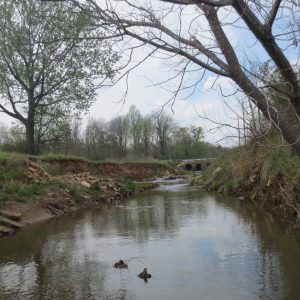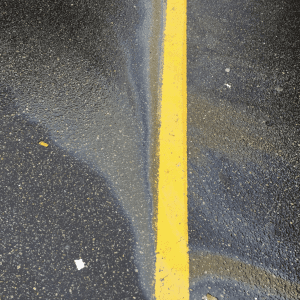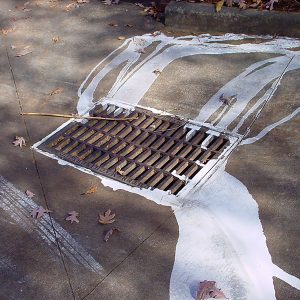Fish & Water

Worldwide water consumption is rising at double the rate of the population; however, the amount of fresh water remains at only 2.5 percent of the world’s water resources.2 Thus, harvesting rainwater on-site has many benefits:
- Reduces stormwater runoff and associated negative impacts of flooding on downstream water quality in highly urbanized areas
- Helps with water conservation and reduces demand on public water supply
- Prepares for times of drought
- Assists with water management in flood- and erosion-prone areas in the home landscape
- Saves money on utility bills for irrigation
- Is better for plants that prefer rainwater, which does not contain chlorine by-products like treated public water does
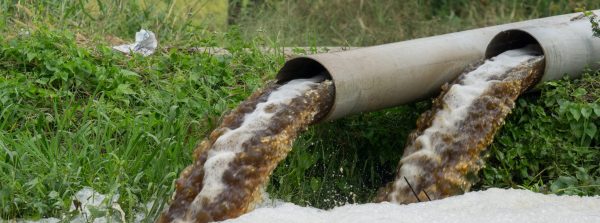
Figure 1. Point source pollution
Reducing Negative Impacts of Stormwater Runoff
Impervious areas, such as roads, rooftops, and sidewalks, leave water with limited opportunity to soak into the ground. When rainwater is not captured for reuse or directed to a pervious area, it runs off and is channeled into nearby storm drains, ditches, and other conveyance devices.
As rainwater travels along impervious surfaces toward storm drains, it picks up pollutants that were left behind on the landscape. These pollutants include sediment, litter (like cigarette butts), fertilizers, pet waste, yard debris, oils, and many other contaminants. These pollutants then get washed away untreated into local streams and rivers at higher volumes, eroding stream banks and polluting the beaches and rivers where we swim, fish, and get our drinking water. This type of pollution is called “stormwater pollution,” and it is the greatest threat to our nation’s surface waters according to the US Environmental Protection Agency.3
Increased impervious areas can lead to localized flooding issues. Less water soaking into the groundwater table also prevents typical groundwater recharge.
Conventional stormwater practices focus on the immediate removal of stormwater from communities into conveyance pipe networks, which typically take stormwater to nearby waterways. As urban areas in Alabama expand and redevelop, the increase in stormwater flows can place tremendous pressure on aging infrastructures. Harvesting rainwater helps by slowly releasing water back into the ground.
- Figure 2. Urban stream with eroded stream bank and little vegetation
- Figure 3. Stormwater can pick up oil from parking lots and enter a storm drain that flows to a local waterway.
- Figure 4. Toxic chemicals (paint) are washed into a storm drain, ending up in local waterways.
Reducing Amount of Drinkable Water Used For Outdoor Irrigation
Did you know that the average American family uses 320 gallons of water per day, about 30 percent of which is devoted to outdoor uses? More than half
of outdoor water use is for irrigation of lawns and gardens.4 Additionally, a considerable amount of energy is required to deliver and treat the water. For example, letting a faucet run for 5 minutes uses about as much energy as keeping a 60-watt light bulb turned on for 14 hours.5
The average annual rainfall amount in Alabama is 56 inches.6 This amount is not guaranteed, however, and long dry spells are common. The impact of climatic events can be reduced through planning, preparing, and helping to recreate the natural hydrology cycle that is disrupted by urbanization. Rainwater harvesting is just one of many ways citizens can help replenish groundwater and reduce nonpoint source pollution.
Does Owning a Rain Barrel Pay Off?
Through a series of case studies it was estimated that if 25 percent of the population in a watershed adopted rainwater harvesting practices, a number of ecological and human health benefits, including reduced use of fresh surface and groundwater, could be gained. Potential maximum lifetime energy cost savings were estimated at $5 million from domestic rainwater harvesting in one watershed and $24 million from agricultural rainwater harvesting in another.7
The United Nations’ World’s Cities report notes, “By 2030, urban areas are projected to house 60 percent of people globally, and one in every three people will live in cities with at least half a million inhabitants.” Now imagine how these large cities will change urban hydrology and impact stormwater pollution.8 Fortunately, we can all take small steps to have a big impact.
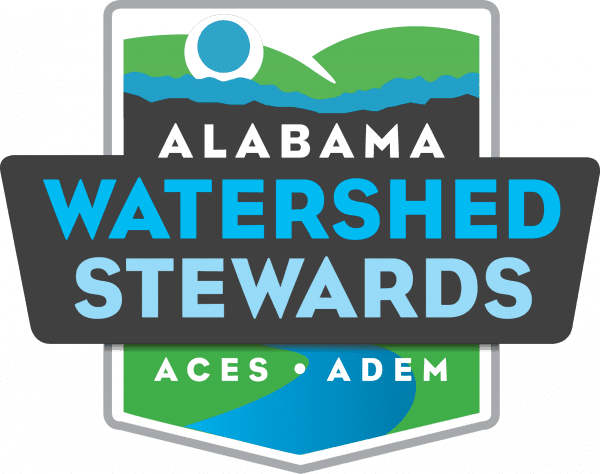
 Laura Bell, Project Coordinator; Eve Brantley, Extension Resources Specialist and Professor; Naomi Pitts, Watershed Program Assistant; and Caitlin Sweeney, Watershed Program Assistant, all with Alabama Extension Water Program, Auburn University
Laura Bell, Project Coordinator; Eve Brantley, Extension Resources Specialist and Professor; Naomi Pitts, Watershed Program Assistant; and Caitlin Sweeney, Watershed Program Assistant, all with Alabama Extension Water Program, Auburn University
Special thanks to Rhonda Britton, Regional Extension Agent, for her contributions to this handbook.
New August 2021, A Homeowner’s Guide to Rainwater Harvesting in Alabama, ANR-2794


